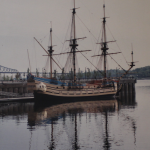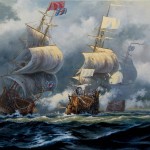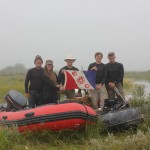Opportunity to come on Expedition
August 2015 – Travel down the Nelson River to York Factory with the Fara Heim Expedition to search for the lost warships of the 1697 Battle of Hudson Bay
In September 1697, a naval battle occurred near the south shores of Hudson Bay in Canada. The battle occurred during King William’s War when the French-Canadian Pierre Le Moyne D’Iberville engaged an English naval squadron at York Fort. D’Iberville’s warship, Le Pelican, had been separated during the trip through the Hudson Strait and arrived before his other ships. Le Pelican had sailed out to guide what D’Iberville thought was three friendly ships through the treacherous shoals. He then engaged the ships (a Royal Navy frigate and 2 armed Hudson’s Bay Company merchantmen) after he realized they were English.
The French-Canadian D’Iberville, born in Montreal (then Ville-Marie), was Captain of Le Pelican (44 guns, 200 ft, 3 masts). The English squadron consisted of 3 frigates including two armed merchant ships, the Dering and Hudson’s Bay (80 guns total), and the HMS Hampshire (46 guns, 110 ft, 3 masts).
The initial engagement between the 4 ships lasted almost 3 hours. Then D’Iberville and Captain John Fletcher of the Hampshire viciously and repeatedly broadsided each other until the Hampshire sunk with all hands lost. The Hudson’s Bay surrendered and the other ship, the Dering, ran when the Hampshire was sunk. The battle has been so savage that Le Pelican couldn’t pursue the Dering and D’Iberville beached his ship to save his crew. Later the captured HBC merchantman, Hudson’s Bay, was also lost.
On shore D’Iberville marched his men through 6 inches of snow in a heavy snowstorm to capture York Fort. The event was recorded by York Fort’s second-in-command Henry Kelsey in his journal. Henry kept daily notes on the battle, negotiations and eventual surrender to D’Iberville. Kelsey is also known to be the first European to see the prairies and bison when he walked from York Fort to the great plains of Saskatchewan.
D’Iberville was an explorer, trader, privateer, and statesman. He considered himself “French-Canadian” and not “French” thogh he sailed under the French flag and reported his activities to the King of France. He is considered by Canada to be one of its greatest soldiers. D’Iberville’s other explorations include finding the mouth of the Mississippi, founding Baton Rouge, Biloxi, and Mobile, and creating the colony of Louisiana. His brother, Jean-Baptiste Le Moyne Bienville, went on to found New Orleans. His father was one of the first settlers to what is now Montreal. In Lachine, the west end of modern Montreal, at the head of the rapids, you can visit the family fur storage warehouse from the 17th century.
The Fara Heim expedition has been to York Factory twice. They have searched the area using satellite imagery, interviewed local sources to collect oral history, analyzed the cartography of the past 300 years against current conditions, evaluated isostatic rebound, used a drone for airborne imagery, completed multiple land and sea searches with magnetometers, and traveled the Nelson River by boat. This expedition will continue the search with a complete suite of electronic sensors and the ability to dive. Fara Heim wants to share the beauty of the land, the significance of the history, and the experience of being on an expedition with a select few Adventurers.
For 2 weeks in August 2015 the Fara Heim expedition will live at York Factory and search using advanced sensor systems for evidence of the remains of the vessels lost. The ships have never been found due to a combination of the remoteness of the site and the lack of technology that a private expedition could access. Fara Heim will use an airborne drone to support the aerial search and a robot sailboat (a“Datamaran”) to search the bottom of the Bay. Fara Heim will be conducting dive operations as necessary though Adventurers will only participate in the above surface searching due to the conditions in Hudson Bay. The team has applied to be a Flag expedition of The Explorers Club (TEC) (www.explorers.org). Most of the Fara Heim team are members of TEC. TEC’s famous past members include Sir Edmond Hillary, Neil Armstrong, Thor Heyerdahl, Vilhjalmur Stefansson, and Roald Amundsen.
Fara Heim will be taking “Adventurers with Purpose” on the expedition for 1-week periods. The Adventurers will travel from Gillam, Manitoba down the Nelson River by boat on a 1-1.5 day trip depending on Bay weather and tides. The trip to York Factory will include a stop at Seal Island (where Sir Thomas Button wintered in 1612), Port Nelson (abandoned over 100 years ago) and sites of local shipwrecks. Belugas, polar bears, wolves, caribous, eagles, ravens, seals, and potentially narwhal and the northern lights will be seen on the trip. Adventurers will camp under the stars at York Factory in the polar bear enclosure (to keep the bears out), walk on Marsh Point with the polar bears, visit the remaining buildings of York Factory, and be part of the land and sea search. Historical and archaeological experts will be part of the expedition to provide Adventurers with insights and education into the significance, history, and events at York Factory. The return trip will be done in one day depending on weather and tides.
The cost for 7 days (Sun-Sat inclusive of food, wine/beer, accommodation, and transport to/from Gillam, Manitoba) is $4500USD. There are only 6 spots available per week due to transportation constraints. For additional cost other transport options can be arranged including directly flying to York Factory via floatplane. For further information please call or email David Collette at 262-960-2959 or david@faraheim.com. For more information on Fara Heim please go to www.faraheim.com.
1 comment Wednesday 11 Feb 2015 | David | Expedition Diary




Hello David – We met at the EC a year or so ago. I’m ER ’74, and my wife, Angela is Editor of The Explorers Journal, among other publications. Understand that you will be in town for the 20th. Don’t know your schedule, but would happily pour you a drink and would like to discuss your very exciting project. There is a lot more to this puzzle than meets the eye, and you should be aware of this. Think about the “Missing Copper from the Houghton Peninsula”, the whale bones found in Michigan, some with very recent carbon dates(<1000) and the Kensington Rune stone. To this mix, I suggest that you look at some of the 16th century maps, showing Hudson Bay in some detail, more than a century before Hudson got there. The Bay is dramatically dynamic.Understanding some of those dynamics will simplify your mission in a productive fashion. Regards, Carl Schuster